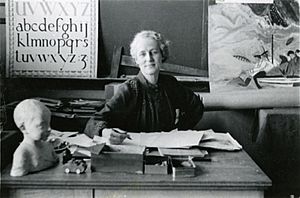Anne Savage (artist) facts for kids
Quick facts for kids
Anne Savage
|
|
|---|---|

Anne Savage sitting at her desk, 1940
|
|
| Born |
Annie Douglas Savage
July 27, 1896 Montreal, Quebec, Canada
|
| Died | March 25, 1971 (aged 74) Montreal, Quebec, Canada
|
| Known for | painter and art teacher |
Anne (Annie) Douglas Savage (born July 27, 1896 – died March 25, 1971) was a talented Canadian painter and art teacher. She was famous for her beautiful landscape paintings that seemed to sing with rhythm. Anne Savage also helped start an important art group called the Canadian Group of Painters.
Contents
Growing Up
Anne Savage was born in Montreal, Quebec, Canada. Her father, John Savage, was a successful businessman. She grew up in a quiet, country-like area called Dorval, Quebec.
Every summer, Anne spent time at her family's cottage in the Laurentian mountains. This is where she fell in love with nature. The beautiful scenery around her became a huge inspiration for her artwork. She went to the High School of Montreal.
Becoming an Artist and Teacher
From 1914 to 1918, Anne studied art at the Art Association of Montreal. She learned from well-known teachers like William Brymner and Maurice Cullen. During this time, her twin brother was sadly killed in France during World War I. This was a very difficult time for her.
After the war, Anne went to Minneapolis, Minnesota. There, she studied design at the Minneapolis School of Art. When she returned to Montreal, she became an art teacher. She taught at Baron Byng High School for 26 years, from 1922 to 1947.
Anne also taught art to children. She believed it was important for young people to experience art early on. Years later, she helped create the Child Art Council in Quebec. This group is now known as the Quebec Society for Education through Art.
Joining Art Groups
In 1921, Anne Savage joined the Beaver Hall Hill Group. These painters worked closely with the famous Group of Seven. A. Y. Jackson, a member of the Group of Seven, became Anne's close friend for life.
Anne also spent time in Toronto with another Group of Seven painter, Arthur Lismer. She studied at the Ontario College of Art. Later, she traveled to Europe, where some of her paintings were shown.
Anne also visited British Columbia. She drew sketches of the villages of Indigenous peoples on the northwest coast. These drawings were shown in 1927 at the National Gallery. The exhibition was called "Canadian West Coast Art, Native and Modern."
In 1933, Anne helped start the Canadian Group of Painters. This was a very important art group. She even served as its president in 1949 and 1960. In 1948, she became the supervisor of art for the Protestant School Board of Montreal. She also helped create the High School Art Teaching Association. In 1955, she inspired the creation of the Child Art Council.
Later Teaching Years
Anne retired from full-time teaching in 1953. She was then named the Supervisor of Art for the Protestant School Board of Greater Montreal. She was also invited to teach at McGill University, where she taught from 1954 to 1959.
Throughout her life, Anne believed in fairness and equality for women. She joined groups like the League for Women's Rights, which worked for women's voting rights in Montreal. She felt that women artists were just as good as men artists.
Later Life
Anne Savage passed away in Montreal in 1971. She was buried in the Mount Royal Cemetery.
You can find Anne Savage's old papers and artworks at Concordia University in Montreal. These are called the Anne Savage Archives.
Works
- Early Settlers, c.1930
- The Wood, 1938
- Le lac le soir, Wonish, c. 1950s
- The Little Pine - Lake Wonish, n.d.

